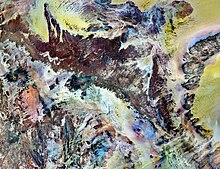
Landsat multilayer image of the Tassili n'Ajjer
| |
| UNESCO World Heritage Site | |
|---|---|
| Location | Algeria |
| Includes | Tassili n'Ajjer Cultural Park |
| Criteria | (i), (iii), (vii), (viii) |
| Reference | 179 |
| Coordinates | 25°40′00″N 9°00′00″E |
| Inscription | 1982 (6th Session) |
Tassili n'Ajjer (Berber: Tasili n Ajjer, Arabic: طاسيلي ناجر, English: Plateau of the Rivers) is a heavily eroded sandstone rock formation in the Algerian section of the Sahara Desert, situated on a vast plateau, that encompasses south-east Algeria, western Libya and northern Niger. It features over 300 rock arches, dense clusters of eroded sandstone rock pillars and steep cliffs and gorges where water pools permanently at the surface.[2] Tassili n'Ajjer covers an area of over 72,000 km2 (28,000 sq mi).[3]
Contents
[hide]Prehistoric art[edit]
The rock formation is an archaeological site, noted for its numerous prehistoric parietal works of rock art, first reported in 1910,[3] that date to the early Neolithic era at the end of the last glacial period during which the Sahara was an inhabitable savanna rather than the current desert. Although sources vary considerably, the earliest pieces of art are assumed to be 12,000 years old.[4] the vast majority date to the 9th and 10th millennia BP or younger, according to OSL dating of associated sediments.[5] Among the 15,000 engravings so far identified depicted are large wild animals including antelopes and crocodiles, cattle herds and humans that engage in activities such as hunting and dancing. According to UNESCO, "The exceptional density of paintings and engravings...have made Tassili world famous."[6]
Geography[edit]
The Tassili n'Ajjer ranges from 26°20′N 5°00′E east-south-east to 24°00′N 10°00′E. Its highest point is the Adrar Afao that peaks at 2,158 m (7,080 ft), located at 25°10′N 8°11′E. The nearest town is Djanet, situated around 10 km (6.2 mi) southwest of Tassili n'Ajjer. The archaeological site has been designated a national park, a Biosphere Reserve (cypresses) and was induced into UNESCO's World Heritage Site list as Tassili n'Ajjer National Park.[7]
The plateau is also of great geological and aesthetic interest, as the panorama of geological formations of "rock forests" of eroded sandstone resembles a strange lunar landscape.[8]
Geology[edit]
The range is composed largely of sandstone. Erosion in the area has resulted in nearly 300 natural rock arches being formed, along with many other spectacular landforms.
Ecology[edit]
Because of the altitude and the water-holding properties of the sandstone, the vegetation here is somewhat richer than in the surrounding desert; it includes a very scattered woodland of the endangered endemic species Saharan Cypress and Saharan Myrtle in the higher eastern half of the range.
The ecology of the Tassili n'Ajjer is more fully described in the article West Saharan montane xeric woodlands, the ecoregion to which this area belongs. The literal English translation of Tassili n'Ajjer is 'Plateau of the rivers' referring to a time when the climate was repeatedly far wetter than it is today (see Neolithic Subpluvial).
Relict populations of the West African crocodile persisted in the Tassili n'Ajjer until the 20th century.[9]
In popular culture[edit]
- Tassili is the recording location and the title of a 2011 album by the Tuareg-Berber band Tinariwen.
- In his 1992 book Food of the Gods, new-age icon Terence McKenna hypothesized that the Neolithic culture that inhabited the site used psilocybin mushrooms as part of its religious ritual life, citing rock paintings showing persons holding mushroom-like objects in their hands, as well as mushrooms growing from their bodies.
- Tassili Plain is a track on the 1994 album Natural Wonders of the World in Dub by dub group Zion Train.
Gallery[edit]
- Rock-Art, Saharan Cypress and Landscapes of the Tassili










沒有留言:
張貼留言
注意:只有此網誌的成員可以留言。